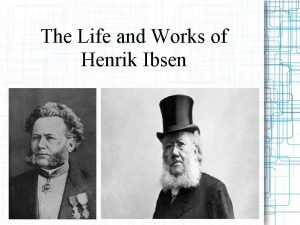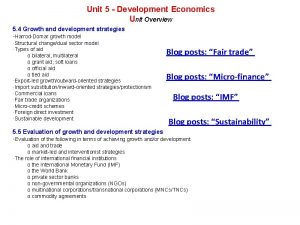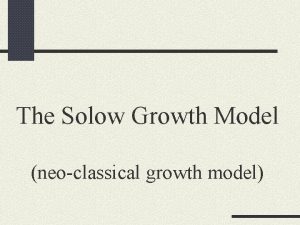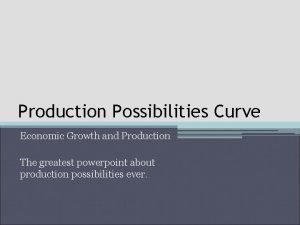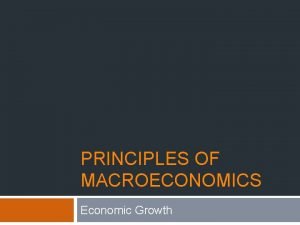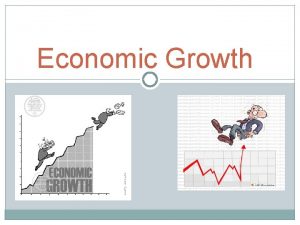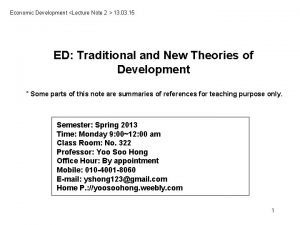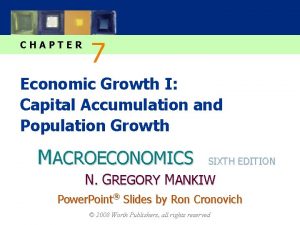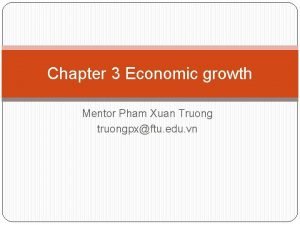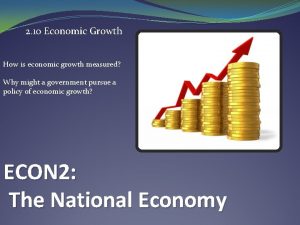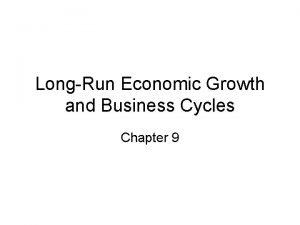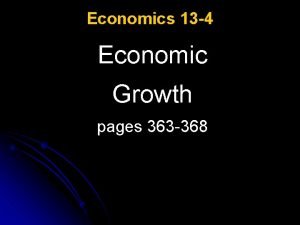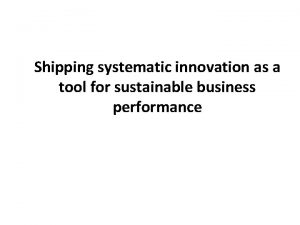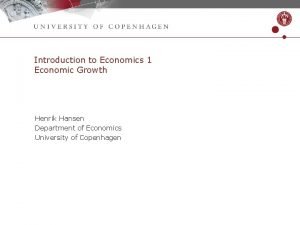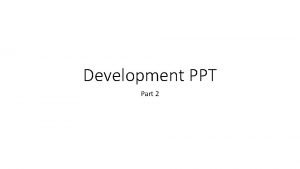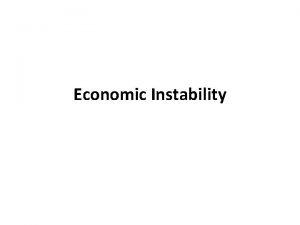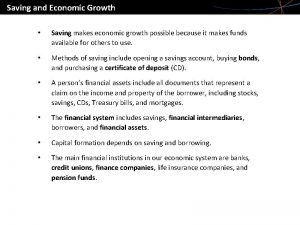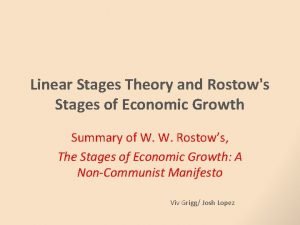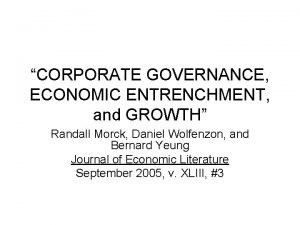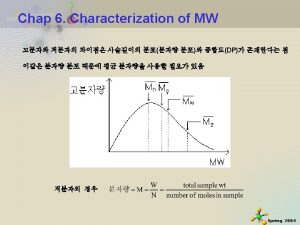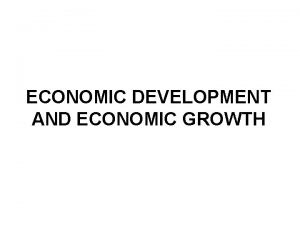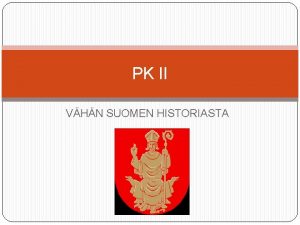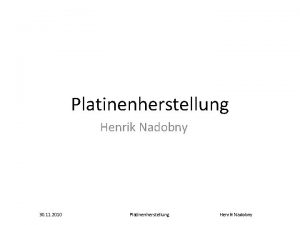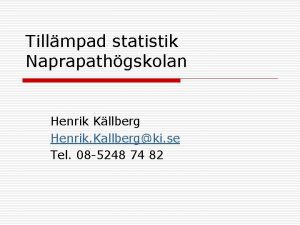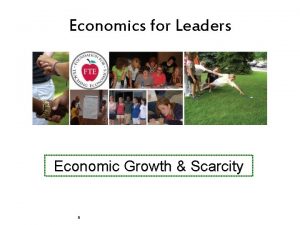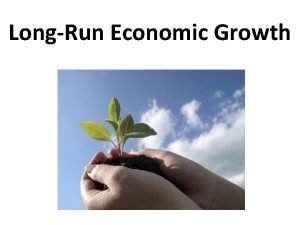Introduction to Economics 1 Economic Growth Henrik Hansen












































- Slides: 44

Introduction to Economics 1 Economic Growth Henrik Hansen Department of Economics University of Copenhagen

Global Development Agenda 1. Meta comments: Introduction to Economics 2. Definitions of “Economics” 3. GDP 4. Economic growth across time and space Dias 2 September 6, 2016

Global Development Introduction to Economics Dias 3 • We have • You read 1. “On the Definition of Economics” by Roger E. Backhouse and Steven G. Medema, Journal of Economic Perspectives, 23(1), 2009, 221 -233. 2. “Economics – A Very Short Introduction” by Pratha Dasgupta, Oxford University Press, 2007: selected chapters (pages) • I pick selected parts of the readings to explain and expand September 6, 2016 2 lectures: Tuesdays 6/9 and 13/9 and 2 seminars: Thursdays 8/9 and 15/9

Global Development The Seminar Thursday, September 8, 2016 You read the 3 papers: 1. Pranab Bardhan and Isha Ray (2006) Methodological Approaches to the Question of the Commons, Economic Development and Cultural Change, Vol. 54, No. 3, pp. 655676. (A quick read is ok) 2. David Mosse (2006) Collective Action, Common Property, and Social Capital in South India: An Anthropological Commentary, Economic Development and Cultural Change, Vol. 54, No. 3, pp. 695 -724. (Not Sections V and VI, pp. 711 -719). 3. Rajiv Sethi and E. Somanathan (2006) A Simple Model of Collective Action, Economic Development and Cultural Change, Vol. 54, No. 3, pp. 725 -747. (Not Sections IIIA and IIIB, pp. 734 -737) Dias 4 September 6, 2016

Global Development At the seminar each class forms 4 -6 groups • Half of the groups in each class must commit to explain the text by Mosse to the other half • Half of the groups in each class must commit to explain the text by Sethi and Somanathan to the other half During the first hour of the seminar • The groups who committed to explain the text by X must first discuss the text by Y and list: 1. Questions of clarification 2. Questions of substance 3. Areas of minor disagreements 4. Areas of major disagreements 5. The amount of time each student has spent reading each of the three texts • The lists are to be written in a word processing program, uploaded to Absalon and given to another group (a swap) During the second hour of the seminar • All groups prepare a presentation and discussion of their chosen text using the received list of questions and disagreements to structure the discussion. • The discussions of the two texts will be the first hour of the seminar the following week. Dias 5 September 6, 2016

Definitions of Economics

Global Development What Our Economics People Said About Their Discipline Dias 7 September 6, 2016

Global Development Selected Textbook Definitions of Economics (Backhouse and Medema) Economics is the study of economies, at both the level of individuals and of society as a whole (Krugman and Wells, 2004, p. 2). Economics is the study of how human beings coordinate their wants and desires, given the decision-making mechanisms, social customs, and political realities of the society (Colander, 2006 a, p. 4). Economics is the study of how society manages its scarce resources (Mankiw, 2001, p. 4). [Economics is the] social science that studies the choices that individuals, businesses, governments, and entire societies make as they cope with scarcity (Bade and Parkin, 2002, p. 5). [E]conomics is the study of human behavior, with a particular focus on human decision making (Gwartney, Stroup, Sobel, and Mac. Pherson 2006, p. 5). Dias 8 September 6, 2016

Global Development The History: From Macro to Micro… If we begin with Adam Smith, it started as Political Economy: The Wealth of Nations and Economic Growth It turned towards the individual and exchange…and then came Alfred Marshall (1890) Political Economy or Economics is a study of mankind in the ordinary business of life; it examines that part of individual and social action which is most closely connected with the attainment and with the use of the material requisites of wellbeing…Thus it is on the one side a study of wealth; and on the other, and more important side, a part of the study of man. Robbins (1932) added scarcity: “the science which studies human behavior as a relationship between ends and scarce means which have alternative uses. ” Dias 9 September 6, 2016

Global Development …to an “Approach” Gary Becker (1976, p. 5) stated, “The combined assumptions of maximizing behavior, market equilibrium, and stable preferences, used relentlessly and unflinchingly, form the heart of the economic approach as I see it. ” Dias 10 September 6, 2016

Global Development Most Economists do without • Modern economists do not subscribe to a homogeneous definition of their subject. • We are tackling subjects as diverse as growth, auctions, crime, and religion with a methodological toolkit that includes real analysis [a branch of math], econometrics [a branch of statistics], laboratory experiments, and historical case studies, and we are debating the explanatory roles of rationality and behavioral norms. • Dias 11 • Thus, any concise definition of economics is likely to be inadequate. • This lack of agreement on a definition does not necessarily pose a problem for the subject. September 6, 2016

Global Development Dasgupta’s Idea of Economics • • Economics in great measure tries to uncover the processes that influence how people’s lives come to be what they are. The discipline also tries to identify ways to influence those very processes so as to improve the prospects of those who are hugely constrained in what they can be and do. The former activity involves finding explanations, while the latter tries to identify policy prescriptions. • Dias 12 Economists also make forecasts of what the conditions of economic life are going to be; but if the predictions are to be taken seriously, they have to be built on an understanding of the processes that shape people’s lives; which is why the attempt to explain takes precedence over forecasting. (A personal statement from a theorist, HH) September 6, 2016

Global Development Understanding Economic Lives Dias 13 • Since everything probably affects everything else, how can we ever make sense of the social world? • The modern economist does this by building models, which are deliberately stripped down representations of the phenomena out there • As economists deal with quantifiable objects the models are almost always mathematical constructs. They can be stated in words, but mathematics is an enormously efficient way to express the structure of a model; more interestingly, for discovering the implications of a model. • The art of good modelling is to generate a lot of understanding from focusing on a very small number of causal factors. September 6, 2016

Global Development An Anthropological Comment on Economists’ Models From: Gudeman, Stephen (2013). Economy's Tension: The Dialectics of Community and Market. Berghahn Books A universal model is self-contained, derivational in form, and apparently complete. It seems to be independent of all local conditions. A derivational model is both essentialist and foundationalist. In it, some knowledge is considered to be non-inferential or selfcontained; requiring no further justification, this knowledge provides the foundation for the remainder. With its levels, the universal model has rules of formation or derivation such as causality and deduction… Each level of economy or society is tied to the final one (foundationalism) that is self-organized or selfsufficient (essentialism). Euclidean geometry, with its axioms and derivations, offers a mathematical example of the consistency that makes universal models persuasive. Coherent, consistent and replicable, it has a bounded structure. Dias 14 September 6, 2016

Global Development Euclidian Geometry Euclidean geometry is a mathematical system attributed to the Alexandrian Greek mathematician Euclid, which he described in his textbook on geometry: the Elements. Euclid's method consists in assuming a small set of intuitively appealing axioms, and deducing many other propositions (theorems) from these. Euclid was the first to show these propositions could fit into a comprehensive deductive and logical system. The Elements begins with plane geometry, still taught in secondary school as the first axiomatic system and the first examples of formal proof. [Source: Wikipedia, https: //en. wikipedia. org/wiki/Euclidean_geometry] Dias 15 September 6, 2016

Global Development Elliptic geometry is a non-Euclidean geometry, in which, given a line L and a point p outside L, there exists no line parallel to L passing through p, as all lines in elliptic geometry intersect. Elliptic geometry has a variety of properties that differ from those of classical Euclidean plane geometry. For example, the sum of the interior angles of any triangle is always greater than 180° Dias 16 September 6, 2016

Global Development An Anthropological Comment on Models, cont’d Local models are worlds apart from universal models. Contingent and mixed constructions, they constitute a world of relationships, objects and beings, or ways of coping with radical uncertainty. They are unfinished as ways of knowing and experiencing the world, and do not exhaust the potentiality for reinterpretation, invention, and aspirations, even as they make a necessary life world. Local models have no given structure and incorporate many forms of reason, such as similarity, analogy, contrast, identity, metaphor, and synecdoche, plus critical, dialectical, causal, and reflexive reason, as well as means-to-ends calculation. Dias 17 September 6, 2016

Global Development Key Points (From Dasgupta) Economics explains social phenomena, such as cooperation or trade, in terms of individual choices and motives. • • Dias 18 The individual is the unit of analysis, and his or her purposive (rational) choices under a set of constraints are what must be explained. • Individuals are self-regarding—they try to do the best they can for themselves given the constraints of their economic endowments, their information sets, and their tastes and preferences • Tastes and preferences are exogenously given and stable Agency and autonomy reside in the individual. Societal characteristics reflect the aggregated result of individual characteristics The art of good modelling is to generate a lot of understanding from focusing on a very small number of causal factors. September 6, 2016

GDP What does GDP measure?

Global Development The Circular Flow of Economic Activity Income ($300) Labor Income = Expenditure = Households. Value of production = GDP Businesses Bread Consumption Expenditure ($300) Dias 20 September 6, 2016

Global Development The Circular Flow of Economic Activity II Income ($? ) Labor Businesses Households Farmer Miller Baker Bread Consumption Expenditure ($? ) Dias 21 September 6, 2016

Global Development Two ways of organizing the business sector Foods Inc. Hire 3 types of labor: 1. Farmers (grain) 2. Millers (flour) 3. Bakers (bread) Pays $300 as wages and profit Sells bread to the household for $300 22/45 September 6, 2016 We. Do. Food Has 3 business sectors 1. Farmers; Sell grain 2. Millers; Buy grain Sell flour 3. Bakers; Buy flour Sell bread

Global Development The Value of Production in We. Do. Food Sales (Value of Production) Farmer sells cereal to miller $100 Miller sells flour to baker $150 $50 Baker sells bread to $300 $150 Total $550 $300 household 23/45 Value Added Income September 6, 2016

Global Development The Circular Flow of Economic Activity II Income ($300) Labor Businesses Households Farmer Miller Baker Bread Consumption Expenditure ($300) Dias 24 September 6, 2016

Global Development A System of National Accounts (SNA) Double Entry Bookkeeping Production Account Goods and Services Out In Value of Production: 550 Use of intermediates: 250 Value of Production: 550 Consumption 300 GDP 300 25/45 September 6, 2016 Income Account Out In Consumption 300 GDP 300

Global Development What is GDP? (II) Output measure: This is the value of the goods and services produced by all sectors of the economy; agriculture, manufacturing, energy, construction, the service sector and government Expenditure measure: This is the value of the goods and services purchased by households and by government, investment in machinery and buildings. It also includes the value of exports minus imports Income measure: The value of the income generated mostly in terms of profits and wages. In theory all three approaches should produce the same number. Dias 26 September 6, 2016

Global Development Taxes and Subsidies Taxes and subsidies Public Sector Factor payment Income Saving Consumption Factor market Households Savings Factor payment Financial Investments Businesses market Saving Consumption Goods market Income Factor Import and payment and Export Taxes and Income Subsidies Rest of World Dias 27 September 6, 2016

Global Development The History of the SNA Dias 28 September 6, 2016

Global Development Denmark and most OECD countries got richer over night in 2014 Dias 29 September 6, 2016

Global Development GDP is more than GDP Name Derived from (only illustrative) GDP current prices SNA (Domestic Statistical offices) GDP current prices, USD Exchange rate*(GDP current prices) GDP current prices, PPP$*(GDP current prices) Real GDP (GDP current prices)/(GDP deflator) Real GDP, USD Exchange rate*(GDP current prices)/(GDP deflator) Real GDP, PPP$*(GDP current prices)/(GDP deflator) Real GDP per capita [(GDP current prices)/(GDP deflator)]/Population Real GDP, USD per capita Exchange rate*[(GDP current prices)/(GDP deflator)]/Population Real GDP, PPP$ per capita Dias 30 September 6, 2016 PPP$*[(GDP current prices)/(GDP deflator)]/Population

Uncover the pathways by which the families came to inherit their current circumstances Economic Growth

Global Development The Pathways to the current circumstances – Economic Growth over the Very Long Run Growth is a recent phenomenon Year 1000: The beginning (we have to start somewhere) 1820: GDP per capita in the world economy is 53% higher than in 1000 – average annual growth rate of 0. 05 % over 820 years 1870: average annual world growth rate: 0. 5% since 1820 1950: average annual world growth rate: 1. 1% since 1870 1980: average annual world growth rate: 2. 5% since 1950 2012: average annual world growth rate: 1. 7% since 1980 2100: average annual world growth rate: 1. 0% since 2012 (expected) Source: Maddison (2001) and Piketty (2014) Dias 32 September 6, 2016

Global Development In recent time (past 200 years) we have seen substantial regional differences in economic growth Source: Maddison (2001) and Heston, Summers and Aten (2011) Dias 33 September 6, 2016

Global Development Growth rates vary enormously across countries The distribution of growth rates in real GDP per capita across countries, 1975 -2009 Dias 34 September 6, 2016

Global Development An Important Task: Understanding Growth Differentials We talk about the proximate causes of economic growth: Accumulation of • Manufactured capital (machines, buildings, bridges, roads, ports) • Human capital (Education, Health) • • Dias 35 New scientific and technological ideas The organization of our economy (“Institutions”) September 6, 2016

A Universal Model: Macro Production Understanding the vast differences in growth rates and production/ income levels, we start from something familiar to economists We assume GDP in a country is produced using physical capital (K), human capital (h) and Labor (L). As we consider GDP use of intermediate input is not included. Moreover we do not consider land or other natural resources. We use math: We standardize by looking at GDP per worker (y = Y/L), (k = K/L)

Comparing Productivity Across Countries Consider GDP per worker in a rich and a poor country: The ratio of output per worker can be decomposed into two ratios: Factors of production and productivity Again, we observe the ratio of output and the ratio of factor inputs. Hence, we can solve for the ratio of productivities Idea: Hall & Jones (1999): Why do some countries produce so much more output per worker than others, QJE 114, 83 -116

The Main Questions for Us 1. How much does productivity differ among countries? 2. How much of the variation in output per worker among countries is “explained” by productivity differences?

Development Accounting for 2009: Big What if Questions

Global Development The relative importance of input factors and productivity 1. Productivity among the poorest 20% of countries in the sample is 15% of the US level: If we shipped Capital and Labor to these countries to reach the US level, production in the US would still be more than 6 times larger. 2. Doing the math we learn that productivity accounts for 53% of the total variation in output per capita, leaving 47% for the factors of production We need to understand productivity differences Dias 40 September 6, 2016

Global Development The organization of societies (institutions) is important for economic growth But what are institutions? • The social sciences differ in their working definitions of institutions… • The Oxford English Dictionary defines institution as ‘an established law, custom, usage, practice, organization, or other element in the political or social life of a people’. Dias 41 • We stress the economic life: Institutions are the arrangements that govern collective undertakings. • “Those arrangements include not only legal entities, like the firm where Becky’s father works, but also the iddir to which Desta’s father belongs. They include the markets in which Becky’s family purchase goods and services, and the rural networks Desta’s household belongs to. They include the nuclear household in Becky’s world and the extended kinship system of claims and obligations in Desta’s world. And they include that overarching entity called government in both their worlds. ” (p. 27) September 6, 2016

Global Development Productivity and Social Capital How do government corruption, ineffectiveness, and indifference to the rule of law translate into the kind of macroeconomic statistics we have been studying here? They leave their imprint on productivity. Other things being equal, a country whose government is corrupt or ineffective, or where the rule of law is not respected, is a country whose productivity is lower than that of a country whose government suffers from fewer of those defects. Some scholars call these intangible but quantifiable factors social infrastructure, others call them social capital. The concept “social capital” is not without problems in interdisciplinary studies because of different uses in Political Science and Economics (Putnam) versus Anthropology and Sociology (Bourdieu) Dias 42 September 6, 2016

Global Development Next Lecture Dias 43 • Classification of goods and services (p. 50 ff) • Markets (Chapter 4) • Households and firms (Chapter 6) September 6, 2016

Global Development Sir Partha Sarathi Dasgupta Born 17 November 1942, is the Frank Ramsey Professor Emeritus of Economics at the University of Cambridge, United Kingdom; Fellow of St John's College, Cambridge; and Professorial Research Fellow at the University of Manchester. He was born in Dhaka, Bangladesh, then moved to India, and is the son of the noted economist A. K. Dasgupta. He is married to Carol Dasgupta, who is a psychotherapist. His father-in-law was the Nobel Laureate James Meade. Dasgupta was educated in Rajghat Besant School in Varanasi, India, obtaining his Matriculation Degree in 1958, and pursued undergraduate studies in Physics at the Hans Raj College, India, graduating in 1962 and in Mathematics at Trinity College Cambridge, graduating in 1965. He obtained a Ph. D in Economics at Cambridge in 1968. His Ph. D supervisor was Nobel Laureate Sir James Mirrlees. Dias 44 September 6, 2016
 Giergev
Giergev Ole henrik hansen
Ole henrik hansen Ole henrik hansen
Ole henrik hansen Ole henrik hansen
Ole henrik hansen Economic growth vs economic development
Economic growth vs economic development Prof. meier and baldwin
Prof. meier and baldwin Henrik ibsen introduction
Henrik ibsen introduction Maastricht university economics and business economics
Maastricht university economics and business economics Econ213
Econ213 Relative growth rates
Relative growth rates Shoot system
Shoot system Carothers equation
Carothers equation Primary growth and secondary growth in plants
Primary growth and secondary growth in plants Primary growth and secondary growth in plants
Primary growth and secondary growth in plants Geometric exponential growth
Geometric exponential growth Neoclassical growth theory vs. endogenous growth theory
Neoclassical growth theory vs. endogenous growth theory Difference between organic and inorganic growth
Difference between organic and inorganic growth Basic concepts of managerial economics
Basic concepts of managerial economics Five stages of economic growth
Five stages of economic growth Solow's model of economic growth
Solow's model of economic growth Interest rates and economic growth
Interest rates and economic growth Ppc curve economic growth
Ppc curve economic growth Long run economic growth
Long run economic growth Long run economic growth graph
Long run economic growth graph Five stages of economic growth
Five stages of economic growth Solow model of economic growth
Solow model of economic growth Solow's model of economic growth
Solow's model of economic growth Long run economic growth graph
Long run economic growth graph Real business cycle theory
Real business cycle theory Why is economic growth important
Why is economic growth important Brazil's quest for economic growth
Brazil's quest for economic growth Economic growth is defined as
Economic growth is defined as Economic growth is defined as
Economic growth is defined as Economic growth and development
Economic growth and development Economic growth occurs when
Economic growth occurs when What is development ppt
What is development ppt Economic growth trends
Economic growth trends Combination of inflation and unmoving economic growth
Combination of inflation and unmoving economic growth Saving makes economic growth possible because
Saving makes economic growth possible because Linear stage theory
Linear stage theory Corporate governance and economic growth
Corporate governance and economic growth Economics unit 1 lesson 2 difficult choices
Economics unit 1 lesson 2 difficult choices Hansen dataset
Hansen dataset The tail joyce hansen
The tail joyce hansen Hansen solubility sphere
Hansen solubility sphere






